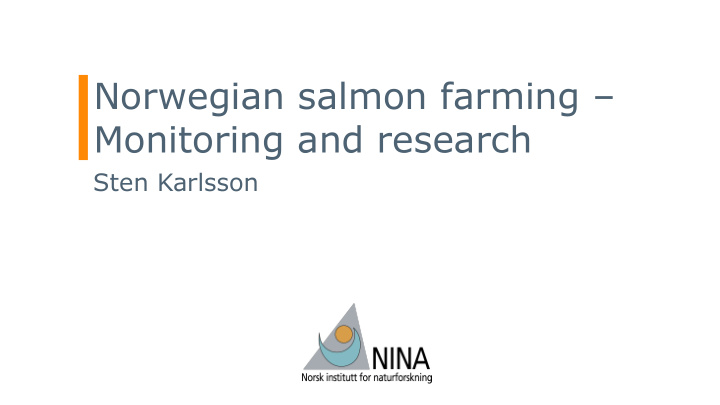



Norwegian salmon farming – Monitoring and research Sten Karlsson
Norwegian Salmon farming Slaughtered farmed salmon metric tons 1.2 Million Tons Farmed salmon 1400000 1200000 1000000 N Escapees - Official reports 800000 600000 1000000 900000 400000 ~500 000 wild salmonrun 800000 200000 700000 N Escapees 0 600000 1993 1995 1997 1999 2001 2003 2005 2007 2009 2011 2013 2015 2017 500000 400000 300000 200000 100000 0 www.nina.no
Nowegian wild salmon • About 400 salmon rivers www.nina.no
Farmed escapees First generation monitoring Second generation programme: 1989 - 2013 monitoring programme: 2014 - 2017 www.nina.no
Farmed to wild genetic introgression Farm Wild ..P(wild) Coord. 2 Finding genetic markers (SNPs) that generically differentiate between Norwegian wild and Wild farmed salmon Coord. 1 www.nina.no
Farmed to wild genetic introgression ▪ 16 407 samples adult salmon ▪ 5155 samples of juveniles ▪ 109 populations ▪ Significant introgression in 51 (47%) ▪ Average introgression 6.4%, Range 0 – 42% ▪ Highest introgression in the most farming intensive regions www.nina.no
Farmed to wild genetic introgression quality norm for wild Atlantic 175 populations evaluated No genetic changes observed 60 54 Weak genetic changes indicated 50 / 60 / 11 29% Moderate significant genetic changes 34% Large significant genetic changes 50 54 / 11 / 31% Now about 40 000 individuals from about 240 populations 6% www.nina.no
Consequences Large effect on Sea-age and growth • Atlantic Phylogenetic grouo 3350 individuals • Different effect in males 22 Large-salmon rivers 26 Small-salmon rivers and females • Different effect in large • Barents/White Sea – and small salmon rivers Phylogenetic group • Phylogenetic origin 751 individuals matters - Different effect 6 Large-salmon rivers in the Atlantic and the 8 Small-salmon rivers Barents/White Sea Phylogenetic groups www.nina.no
Samarbeid og kunnskap for framtidas miljøløsninger Foto. A. Staverløkk www.nina.no
Recommend
More recommend